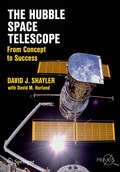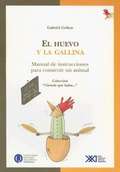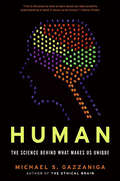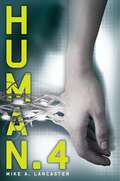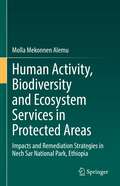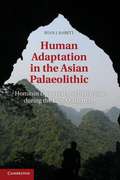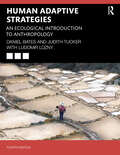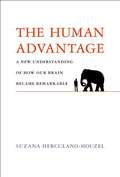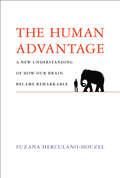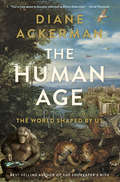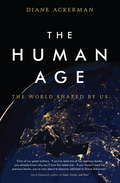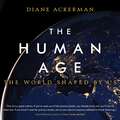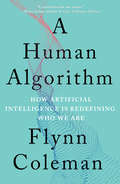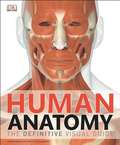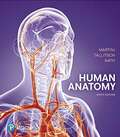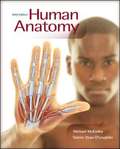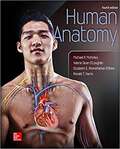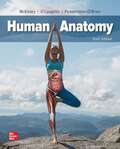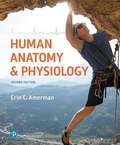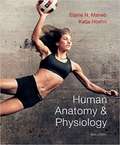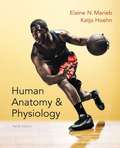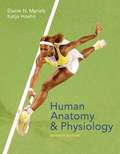- Table View
- List View
Hubble Legacy: 30 Years of Discoveries and Images
by Jim BellThe definitive book on the Hubble Space Telescope, written by a noted astronomer, geologist, and planetary scientist. Looking deep into space, by definition, means looking back in time—and the Hubble Space Telescope can look very far back, including at stars, nebulae, and galaxies that are millions, even billions, of years old. If there is a single legacy of Hubble as it turns thirty years old and nears the end of its useful life, it is this: It has done more to chronicle the origin and evolution of the known universe than any other instrument ever created. Hubble has also captured an astounding collection of ultraviolet images that include geysers of solar light, Mars&’ famous dust storms, exploding stars, solar flares, globular clusters, and actual galaxies colliding. As for scientific milestones, Hubble has helped us learn that the universe is 13.8 billion years old, that just about every large galaxy features a black hole at its center, and that it's possible to create 3-D maps of dark matter. Hubble Legacy will not only feature the most stunning imagery captured by the telescope, but also explain how Hubble has advanced our understanding of the universe and our very creation.Praise for Hubble Legacy &“Along with his clear description of the Hubble Space Telescope&’s setbacks and successes, Jim Bell has compiled an exquisite collection of stunning photographs of the universe. Have many long looks— your tax dollars at work— an astronomer&’s catalog of the cosmos.&” —Bill Nye, CEO, The Planetary Society &“You can&’t flip through this stunning collection of Hubble images without pausing often to shake your head in awe. The accompanying text that Contributing Editor Jim Bell wrote is equally enriching. Altogether, this coffee-table book is a riveting celebration of the venerable space telescope&’s 30th anniversary.&” —Sky & Telescope
The Hubble Space Telescope
by David J. Shayler David M. HarlandThe highly successful Hubble Space Telescope was meant to change our view and understanding of the universe. Within weeks of its launch in 1990, however, the space community was shocked to find out that the primary mirror of the telescope was flawed. It was only the skills of scientists and engineers on the ground and the daring talents of astronauts sent to service the telescope in December 1993 that saved the mission. For over two decades NASA had developed the capabilities to service a payload in orbit. This involved numerous studies and the creation of a ground-based infrastructure to support the challenging missions. Unique tools and EVA hardware supported the skills developed in crew training that then enabled astronauts to complete a demanding series of spacewalks. Drawing upon first hand interviews with those closely involved in the project over thirty years ago this story explains the development of the servicing mission concept and the hurdles that had to be overcome to not only launch the telescope but also to mount the first servicing mission - a mission that restored the telescope to full working order three years after its launch, saved the reputation of NASA, and truly opened a new age in understanding of our place in space. This is not just a tale of space age technology, astronauts and astronomy. It is also a story of an audacious scientific vision, and the human ingenuity and determination to overcome all obstacles to make it possible. Hubble Space Telescope: From Concept to Success is a story of an international partnership, dedicated teamwork and a perfect blend of human and robotic space operations that will inspire people of all ages. The subsequent servicing missions that enabled the telescope to continue its scientific program beyond its 25th year in orbit are described in a companion volume Enhancing Hubble's Vision: Servicing a National Treasure.
El huevo y la gallina Manual para construir un animal
by Gabriel Gellon"La gallina es la forma que tiene el huevo para hacer otro huevo", supo decir Samuel Butler. Y es una explicación tan buena como cualquier otra o, al menos, es una respuesta posible a uno de los mayores desafíos de la biología moderna. Porque pese a los enormes avances en biología molecular y en la traducción de esa maraña que es el genoma humano, hay dos cuestiones fundamentales para las que recién estamos vislumbrando las preguntas (que para las respuestas, ya habrá tiempo): cómo funciona el cerebro y, sobre todo, cómo a partir de una célula de mamá y papá, se llega a un embrión y a un bebé sapo, bebé gallina, bebé lombriz o bebé humano. Las preguntas son fascinantes: ¿cómo a partir de una única célula se llega a un organismo entero, con partes y funciones tan diferentes entre sí? ¿Cómo "sabe" un embrión qué genes tiene que encender o apagar a lo largo de su desarrollo? ¿Por qué tenemos la cabeza en la cabeza y la cola en la cola, y no al revés? En éste libro lleno de éstas y otras preguntas maravillosas, Gabriel Gellon nos lleva a través de las posibles respuestas, como un guía con el que recorremos las historia de las ideas y los experimentos de la biología del desarrollo. Así, nos sorprendemos junto con Aristóteles al mirar lo que pasa dentro de los huevos, exploramos el manual de instrucciones que llevamos dentro y nos emocionamos al entender cómo se va formando una mosquita pequeña, tan dulce ella. Y si algún lector se desilusiona frente a la ausencia de cigüeñas o repollos, tendrá muchas más historias maravillosas (y reales) con las que asombrarse y quedarse pensando en todo lo que pasó desde que éramos un proyecto en la cabeza de un par de jóvenes enamorados hasta ser el hombre que lee estas líneas. Esta colección de divulgación científica está escrita por científicos que creen que ya es hora de asomar la cabeza por fuera del laboratorio y contar las maravillas, grandezas y miserias de la profesión. Porque de eso se trata: de contar, de compartir un saber que, si sigue encerrado, puede volverse inútil. Ciencia que ladra ... no muerde, sólo da señales de que cabalga. (Diego Golombek)
Human: The Science Behind What Makes Your Brain Unique
by Michael S. GazzanigaWhat happened along the evolutionary trail that made humans so unique? In his accessible style, Michael Gazzaniga pinpoints the change that made us thinking, sentient humans different from our predecessors. He explores what makes human brains special, the importance of language and art in defining the human condition, the nature of human consciousness, and even artificial intelligence.
Human.4
by Mike A. LancasterKyle Straker volunteered to be hypnotized at the annual community talent show, expecting the same old lame amateur acts. But when he wakes up, his world will never be the same. Televisions and computers no longer work, but a strange language streams across their screens. Everyone's behaving oddly. It's as if Kyle doesn't exit. Is this nightmare a result of the hypnosis? Will Kyle wake up with a snap of fingers to roars of laughter? Or is this something much more sinister? Narrated on a set of found cassette tapes at an unspecified point in the future, Human.4 is an absolutely chilling look at technology gone too far.
Human Activity, Biodiversity and Ecosystem Services in Protected Areas: Impacts and Remediation Strategies in Nech Sar National Park, Ethiopia
by Molla Mekonnen AlemuThis book examines the development needs of protected areas with threatened ecological biodiversity to gain deeper understanding of the local perspective of protected area ecosystems. The study focuses on the case of Nech Sar National Park in Ethiopia, a protected area facing many development challenges due to human over-utilization of its resources and threats to wildlife. The conceptual framework developed by this research makes an academic contribution in the protection and sustainable development of national parks' natural capital, since it is designed to provide a systemic analysis of the problem by showing the extent and magnitude of human induced impacts on the natural capital of protected areas. In line with this, the application of the framework produces new and evidence-based findings which will help to improve the governance of protected areas as the research will provide park authorities with a practical tool in addressing the underlying causes of the degradation of national parks before the state of degradation of these resources reach its irreversible juncture. The book will help academicians and researchers to assess the state of biodiversity resources in protected areas using Nech Sar National Park as a representative example of a threatened area common throughout Africa, and will enable development practitioners and policy makers to devise appropriate strategies such as community participation in the governance of protected areas that could help to halt the degradation of resources in protected areas.
Human Adaptation in the Asian Palaeolithic
by Ryan J. RabettThis book examines the first human colonization of Asia and particularly the tropical environments of Southeast Asia during the Upper Pleistocene. In studying the unique character of the Asian archaeological record, it reassesses long-accepted propositions about the development of human 'modernity. ' Ryan J. Rabett reveals an evolutionary relationship between colonization, the challenges encountered during this process - especially in relation to climatic and environmental change - and the forms of behaviour that emerged. This book argues that human modernity is not something achieved in the remote past in one part of the world, but rather is a diverse, flexible, responsive, and ongoing process of adaptation.
Human Adaptive Strategies: An Ecological Introduction to Anthropology
by Daniel Bates Judith Tucker Ludomir LoznyThis book introduces students to cultural anthropology with an emphasis on environmental and evolutionary approaches, focusing on how humans adapt to their environment and how the environment shapes culture. It shows how cultures evolve within the context of people’s strategies for surviving and thriving in their environments.This approach is widely used among scholars as a cross-disciplinary tool that rewards students with valuable insights into contemporary developments. Drawing on anthropological case studies, the authors address immediate human concerns such as the costs and consequences of human energy requirements, environmental change and degradation, population pressure, social and economic equity, and planned and unplanned change. Impacts of increasingly rapid climatic change on equitable access to resources and issues of human rights are discussed throughout. Towards the end of the book the student is drawn into a challenging thought experiment addressing the possible impacts of climatic warming on Middle America in the year 2040. All chapters conclude with "Summary," "Key Terms," and "Suggested Readings." This book is an ideal text for students of introductory anthropology and archaeology, environmental studies, world history, and human and cultural ecology courses.
The Human Advantage: A New Understanding of How Our Brain Became Remarkable
by Suzana Herculano-HouzelHumans are awesome. Our brains are gigantic, seven times larger than they should be for the size of our bodies. The human brain uses 25% of all the energy the body requires each day. And it became enormous in a very short amount of time in evolution, allowing us to leave our cousins, the great apes, behind. So the human brain is special, right? Wrong, according to Suzana Herculano-Houzel. Humans have developed cognitive abilities that outstrip those of all other animals, but not because we are evolutionary outliers. The human brain was not singled out to become amazing in its own exclusive way, and it never stopped being a primate brain. If we are not an exception to the rules of evolution, then what is the source of the human advantage?<P><P> Herculano-Houzel shows that it is not the size of our brain that matters but the fact that we have more neurons in the cerebral cortex than any other animal, thanks to our ancestors' invention, some 1.5 million years ago, of a more efficient way to obtain calories: cooking. Because we are primates, ingesting more calories in less time made possible the rapid acquisition of a huge number of neurons in the still fairly small cerebral cortex -- the part of the brain responsible for finding patterns, reasoning, developing technology, and passing it on through culture.<P> Herculano-Houzel shows us how she came to these conclusions -- making "brain soup" to determine the number of neurons in the brain, for example, and bringing animal brains in a suitcase through customs. The Human Advantage is an engaging and original look at how we became remarkable without ever being special.
The Human Advantage: A New Understanding of How Our Brain Became Remarkable
by Suzana Herculano-HouzelWhy our human brains are awesome, and how we left our cousins, the great apes, behind: a tale of neurons and calories, and cooking.Humans are awesome. Our brains are gigantic, seven times larger than they should be for the size of our bodies. The human brain uses 25% of all the energy the body requires each day. And it became enormous in a very short amount of time in evolution, allowing us to leave our cousins, the great apes, behind. So the human brain is special, right? Wrong, according to Suzana Herculano-Houzel. Humans have developed cognitive abilities that outstrip those of all other animals, but not because we are evolutionary outliers. The human brain was not singled out to become amazing in its own exclusive way, and it never stopped being a primate brain. If we are not an exception to the rules of evolution, then what is the source of the human advantage? Herculano-Houzel shows that it is not the size of our brain that matters but the fact that we have more neurons in the cerebral cortex than any other animal, thanks to our ancestors' invention, some 1.5 million years ago, of a more efficient way to obtain calories: cooking. Because we are primates, ingesting more calories in less time made possible the rapid acquisition of a huge number of neurons in the still fairly small cerebral cortex—the part of the brain responsible for finding patterns, reasoning, developing technology, and passing it on through culture. Herculano-Houzel shows us how she came to these conclusions—making “brain soup” to determine the number of neurons in the brain, for example, and bringing animal brains in a suitcase through customs. The Human Advantage is an engaging and original look at how we became remarkable without ever being special.
The Human Age: The World Shaped By Us
by Diane AckermanAs Diane Ackerman writes in her brilliant new book, The Human Age, "our relationship with nature has changed...radically, irreversibly, but by no means all for the bad. Our new epoch is laced with invention. Our mistakes are legion, but our talent is immeasurable." Ackerman is justly celebrated for her unique insight into the natural world and our place in it. In this landmark book, she confronts the unprecedented reality that one prodigiously intelligent and meddlesome creature, Homo sapiens, is now the dominant force shaping the future of planet Earth. Humans have "subdued 75 percent of the land surface, concocted a wizardry of industrial and medical marvels, strung lights all across the darkness." We tinker with nature at every opportunity; we garden the planet with our preferred species of plants and animals, many of them invasive; and we have even altered the climate, threatening our own extinction. Yet we reckon with our own destructive capabilities in extraordinary acts of hope-filled creativity: we collect the DNA of vanishing species in a "frozen ark," equip orangutans with iPads, and create wearable technologies and synthetic species that might one day outsmart us. With her distinctive gift for making scientific discovery intelligible to the layperson, Ackerman takes us on an exhilarating journey through our new reality, introducing us to many of the people and ideas now creating--perhaps saving--our future and that of our fellow creatures. A beguiling, optimistic engagement with the changes affecting every part of our lives, The Human Age is a wise and beautiful book that will astound, delight, and inform intelligent life for a long time to come.
The Human Age: The World Shaped by Us
by Diane Ackerman'Our relationship with nature has changed . . . radically, irreversibly, but by no means all for the bad. Our new epoch is laced with invention. Our mistakes are legion, but our talent is immeasurable.'In The Human Age award-winning nature writer Diane Ackerman confronts the fact that the human race is now the single dominant force of change on the planet. Humans have 'subdued 75 per cent of the land surface, concocted a wizardry of industrial and medical marvels, strung lights all across the darkness'. We now collect the DNA of vanishing species in a 'frozen ark', equip orang-utans with iPads, create wearable technologies and synthetic species that might one day outsmart us. Ackerman takes us on an exciting journey to understand this bewildering new reality, introducing us to many of the people and ideas now creating - perhaps saving - the future.The Human Age is a surprising, optimistic engagement with the dramatic transformations that have shaped, and continue to alter, our world, our relationship with nature and our prospects for the future. Diane Ackerman is one of our most lyrical, insightful and compelling writers on the natural world and The Human Age is a landmark book.
The Human Age: The World Shaped by Us
by Diane Ackerman'Our relationship with nature has changed . . . radically, irreversibly, but by no means all for the bad. Our new epoch is laced with invention. Our mistakes are legion, but our talent is immeasurable.'In The Human Age award-winning nature writer Diane Ackerman confronts the fact that the human race is now the single dominant force of change on the planet. Humans have 'subdued 75 per cent of the land surface, concocted a wizardry of industrial and medical marvels, strung lights all across the darkness'. We now collect the DNA of vanishing species in a 'frozen ark', equip orang-utans with iPads, create wearable technologies and synthetic species that might one day outsmart us. Ackerman takes us on an exciting journey to understand this bewildering new reality, introducing us to many of the people and ideas now creating - perhaps saving - the future.The Human Age is a surprising, optimistic engagement with the dramatic transformations that have shaped, and continue to alter, our world, our relationship with nature and our prospects for the future. Diane Ackerman is one of our most lyrical, insightful and compelling writers on the natural world and The Human Age is a landmark book.(P)2014 Headline Digital
A Human Algorithm: How Artificial Intelligence Is Redefining Who We Are
by Flynn ColemanA groundbreaking narrative on the urgency of ethically designed AI and a guidebook to reimagining life in the era of intelligent technology.The Age of Intelligent Machines is upon us, and we are at a reflection point. The proliferation of fast–moving technologies, including forms of artificial intelligence akin to a new species, will cause us to confront profound questions about ourselves. The era of human intellectual superiority is ending, and we need to plan for this monumental shift.A Human Algorithm: How Artificial Intelligence Is Redefining Who We Are examines the immense impact intelligent technology will have on humanity. These machines, while challenging our personal beliefs and our socioeconomic world order, also have the potential to transform our health and well–being, alleviate poverty and suffering, and reveal the mysteries of intelligence and consciousness. International human rights attorney Flynn Coleman deftly argues that it is critical that we instill values, ethics, and morals into our robots, algorithms, and other forms of AI. Equally important, we need to develop and implement laws, policies, and oversight mechanisms to protect us from tech’s insidious threats.To realize AI’s transcendent potential, Coleman advocates for inviting a diverse group of voices to participate in designing our intelligent machines and using our moral imagination to ensure that human rights, empathy, and equity are core principles of emerging technologies. Ultimately, A Human Algorithm is a clarion call for building a more humane future and moving conscientiously into a new frontier of our own design.“[Coleman] argues that the algorithms of machine learning––if they are instilled with human ethics and values––could bring about a new era of enlightenment.” —San Francisco Chronicle
Human Anatomy: The Definitive Visual Guide
by Dorling Kindersley Publishing Staff<p>For students of anatomy, biology, and the biomedical sciences; medical professionals; and curious families, DK's Human Anatomy will be a definitive resource. <p>Written by acclaimed anatomist, Dr. Alice Roberts, Human Anatomy is an up-to-the-minute study of the body. Spectacular digital images show the body in incredible, true-to-life detail. Exhaustive annotations provide the names of organs and structures throughout the skeletal, muscular, nervous, cardiovascular, lymphatic, and reproductive systems, while describing their characteristics and functions. <p>This new addition to DK's award-winning catalog of human body titles will help readers better grasp the deep complexities of the human body for research, study, or general reference.</p>
Human Anatomy
by Frederic H. Martini Inc. Robert B. Tallitsch Judi NathFor courses in one-semester human anatomy. <p><p> A fresh voice strengthens a visually compelling, classic human anatomy text. <p> Revered for its groundbreaking, atlas-style format, detailed illustrations, and exceptionally clear photographs, Human Anatomy has long been known for its quality and sophistication, as well as its scope and level of coverage. Accomplished author and award-winning educator Judi Nath joins the writing team, bringing a fresh voice, enhanced accuracy, and a clear, engaging writing style to the 9th Edition. <p><p> The new edition builds upon the legacy of previous editions and includes expanded clinical content to help students focus on the types of diseases and injuries they are likely to encounter in their future careers; visually stunning Spotlight Figures in every chapter to guide students through complex topics; and new features that focus students on the key point in each section and use simple analogies and memory devices to help students remember facts and concepts.
Human Anatomy
by Mckinley Michael Mckinley Valerie O'LoughlinWith its unrivaled art program and accessible writing style, McKinley/O'Loughlin's Human Anatomy stands apart from other anatomy texts. High-quality photographs paired with brilliantly rendered illustrations help students visualize, understand, and appreciate the wonders of human anatomy. Student-friendly Study Tips, Clinical View boxes, and progressive question sets motivate students to internalize and apply what they've learned. Users who purchase Connect Plus receive access to the full online ebook version of the textbook.
Human Anatomy
by Michael McKinley Valerie O'Loughlin Ronald Harris Elizabeth Pennefather-O'BrienWith its unrivaled art program and accessible writing style, McKinley et al.'s Human Anatomy stands apart from other anatomy texts. High-quality photographs paired with brilliantly rendered illustrations help students visualize, understand, and appreciate the wonders of human anatomy. <p><p> The author team incorporates their over seventy years of teaching experience into student-friendly Learning Strategies, Clinical View boxes, and progressive question sets that motivate students to internalize and apply what they've learned. Users who purchase Connect Plus receive access to the full online eBook version of the textbook, as well full access to LearnSmart, SmartBook, and Anatomy & Physiology Ӏ REVEALED.
Human Anatomy
by Michael McKinley Valerie O'Loughlin Elizabeth Pennefather-O'BrienHuman Anatomy stands apart from other texts as it guides students on a clearly written and expertly illustrated beginner’s path through the human body. High-quality photographs paired with brilliantly rendered illustrations help students visualize, understand, and appreciate the wonders of human anatomy. The author team incorporates their combined 70 years of teaching experience into student-friendly learning strategies, built around a pedagogical framework designed to foster retention and encourage the application of knowledge and understanding.
Human Anatomy (4th Edition)
by Elaine N. Marieb Jon Mallatt Patricia Brady WilhelmThis textbook features chapters concentrating on cells, embryology, tissues, bones, joints, muscle tissue, the senses, blood, the heart, blood vessels, and surface anatomy, as well as the various body systems. A brief atlas contains 71 color photographs depicting organs, muscles, and bones. A companion CD-ROM contains interactive tutorials, practice tests, case studies, visual review exercises, and news articles. The authors teach at Holyoke Community College, Washington State University, and the Community College of Rhode Island. Annotation ©2004 Book News, Inc. , Portland, OR (booknews. com)
Human Anatomy And Physiology
by Erin AmermanHuman Anatomy & Physiology speaks to the way today’s diverse students learn and study. In the 2nd Edition, author Erin Amerman strengthens her distinctive learner-centered approach by focusing on three unique pillars. First, Amerman uses art to present one-concept-at-a-time before bringing the distinct parts together in one summarizing Big Picture figure. Second, Amerman coaches students right when they need it, beginning on page one where the opening module titled How To Succeed in Your Anatomy & Physiology Course appears. And finally, she provides students with ample opportunities to practice and develop critical-thinking skills through questions about case studies and real-world scenarios.
Human Anatomy And Physiology
by Elaine N. Marieb Katja N. HoehnNinth Edition of the best-selling Human Anatomy & Physiology, trusted authors Elaine N. Marieb and Katja Hoehn have produced the most accessible, comprehensive, up-to-date and visually stunning anatomy & physiology textbook on the market. Marieb draws on her career as an A&P professor and her experience completing her nursing education; Hoehn relies on her medical education and award-winning classroom instruction—together, they explain anatomy & physiology concepts and processes in a meaningful and memorable way.
Human Anatomy and Physiology 10th Edition
by Elaine N. Marieb Katja HoehnHuman Anatomy and Physiology is organized under the following units : 1)Organization of the Body 2)Covering, Support, and Movement of the Body 3)Regulation and Integration of the Body and 4) Maintenance of the Body.
Human Anatomy and Physiology (4th edition)
by Elaine N. MariebIn this text Marieb (Holyoke Community College) integrates the relationships of body organ systems, homeostasis, and complementarity of structure and function.
Human Anatomy and Physiology (7th Edition)
by Elaine Nicpon Marieb Katja HoehnWith each edition of her top-selling "Human Anatomy & Physiology" text, Elaine N. Marieb draws on her own, unique experience as a full-time A&P professor and part-time nursing student to explain concepts and processes in a meaningful and memorable way. With the "Seventh Edition," Dr. Marieb has teamed up with co-author Katja Hoehn to produce the most exciting edition yet, with beautifully-enhanced muscle illustrations, updated coverage of factual material and topic boxes, new coverage of high-interest topics such as Botox, designer drugs, and cancer treatment, and a comprehensive instructor and student media package. The Human Body: An Orientation, Chemistry Comes Alive, Cells: The Living Units, Tissue: The Living Fabric, The Integumentary System, Bones and Skeletal Tissues, The Skeleton, Joints, Muscles and Muscle Tissue, The Muscular System, Fundamentals of the Nervous System and Nervous Tissue, The Central Nervous System, The Peripheral Nervous System and Reflex Activity, The Autonomic Nervous System, The Special Senses, The Endocrine System, Blood, The Cardiovascular System: The Heart, The Cardiovascular System: Blood Vessels, The Lymphatic System, The Immune System: Innate and Adaptive Body Defensives, The Respiratory System, The Digestive System, Nutrition, Metabolism, and Body Temperature Regulation, The Urinary System, Fluid, Electrolyte, and Acid-Base Balance, The Reproductive System, Pregnancy and Human Development, Heredity For all readers interested in human anatomy & physiology.

